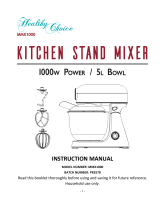
OTHER IMPORTANT INFORMATIONS
For bread making
Flour is the most important ingredient used for
bread making. It provides food for the yeast and
gives structure to the loaf. When mixed with liq-
uid, the protein in the flour starts to form gluten.
Gluten is a network of elastic strands that inter-
lock to trap the gases produced by yeast. This
process increases as the dough continues knead-
ing and provides the structure required to pro-
duce the weight and shape of the baked bread.
White wheat flour, sold as baker’s, bread or
plain flour may be used. Plain flour is most read-
ily available, however, best results are obtained
with flour at least 11–12% protein content. For
this reason, the recipes in this book requiring
bread flour have been made with flour with 11%
protein content. This is normally indicated on
the packaging. Do not sift the flour or use self-
raising flour for bread making unless indicated
in the recipe.
NOTE.
When using a low-protein, plain, stone
ground or wholemeal flour the quality
of the bread can be improved by adding
gluten flour.
Wholemeal wheat flour contains the bran, germ
and flour of the wheat grain. Although breads
baked with this type of flour will be higher in
fibre, the loaf may be heavier in texture. Lighter
textured bread can be achieved by replacing
1 cup of wholemeal flour with white bread flour.
Rye flour, popular for bread making, is low in
protein so it is essential to combine rye flour
with bread flour to make the bread rise success-
fully. Rye flour is traditionally used to make the
heavy, dense Pumpernickel and Black Breads.
Gluten flour is made by extracting the gluten
portion from the wheat grain. Adding gluten
flour can improve the structure and quality of
bread when using low-protein, plain, stone
ground and whole meal flour.
Bread mixes contain flour, sugar, milk, salt, oil and
other ingredients such as bread improves. Usually
only the addition of water and yeast is required.
Bread improvers are available nationally in
supermarkets and health food stores. The ingre-
dients in a bread improver are usually a food acid
such as ascorbic acid (Vitamin C) and other en-
zymes (amylases) extracted from wheat flours.
Adding a bread improver will help strengthen
the dough resulting in a loaf that is higher in
volume, softer in texture, more stable and has
improved keeping qualities.
Sugar provides sweetness and flavour, browns
the crust and produces food for the yeast. White
sugar, brown sugar, honey and golden syrup are
all suitable to use. When using honey or golden
syrup it must be counted as additional liquid.
Powdered milk and milk products enhance
the flavour and increase the nutritional value of
bread. Powdered milk is convenient and easy to
use (store in an airtight container in the refrig-
erator). Low fat or skim milk powder can be used
with good results. Soy milk powder can also
be used but produces a denser loaf. Fresh milk
should not be substituted unless stated in the
recipe.
Salt is an important ingredient in bread mak-
ing. In the dough, salt increases water absorp-
tion, improves kneading, strengthens the glu-
ten development and controls fermentation of
the yeast which results in improved loaf shape,
crumb structure, crust colour, flavour and keep-
ing qualities. As salt inhibits the rising of bread
be accurate when measuring.
Fat adds flavour and retains the moisture. Ve-
getable oils such as safflower, sunflower, canola,
etc. can be used. Butter or margarine can be sub-
stituted for oil in recipes but may give a yellow
coloured crumb.
Yeast is used as the raising agent for the breads
and requires liquid, sugar and warmth to grow
and rise. Dried yeast has been used in the reci-
pes in this instruction book where appropriate.
Before using dried yeast always check the use by
date, as stale yeast will prevent the bread from
rising.
OTHER IMPORTANT INFORMATIONS
19




















